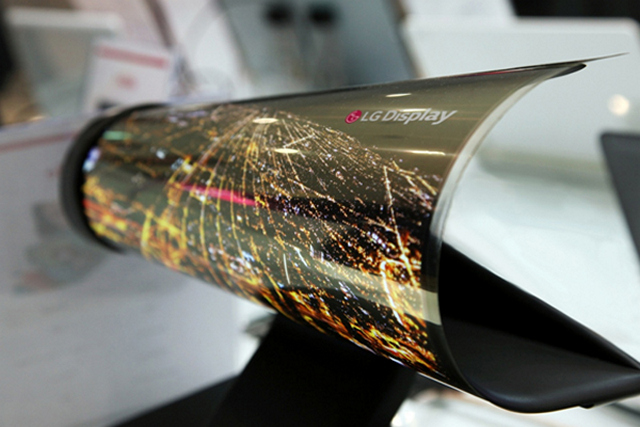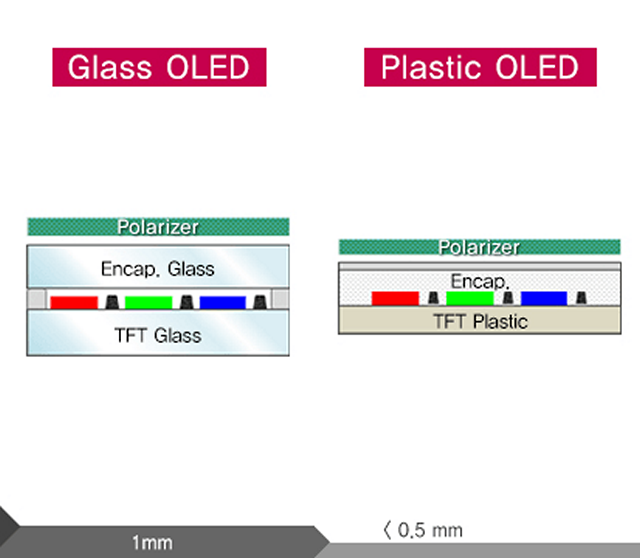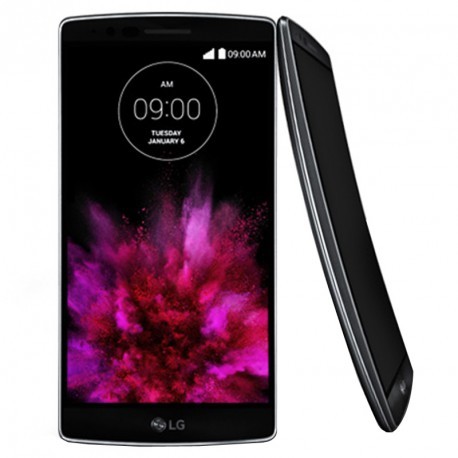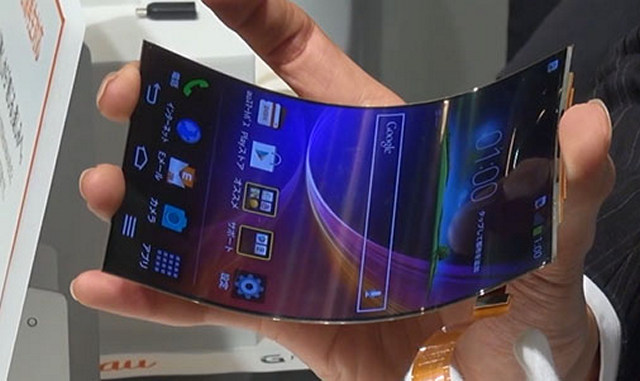POLED vs OLED : What are the Differences?

LED displays, in their various avatars, have become the most popular display technology for consumer gadgets these days. LED, OLED, AMOLED, and other such acronyms have become a part of our daily dictionary, as everything from smartphones to smartwatches and televisions to computer monitors, apply some variation or other of this same underlying display applied science to provide consumers with loftier-quality yet price-effective solutions. With technology progressing at a rapid pace, another new LED technology is now existence tipped past industry experts and tech enthusiasts alike to climb upwards the popularity charts rapidly going forrad. Called 'POLED or P-OLED', the upward-and-coming technology is expected to go mainstream sooner rather than later. So what is POLED and why is it creating waves in the tech circles?
What is POLED and How Does it Work?
POLED, or Plastic Light Emitting Diode, is a brandish technology that uses a flexible plastic substrate such equally polyethylene terephthalate (PET) instead of glass for the electroluminescent organic semiconductor to exist deposited. The utilise of more than malleable plastic instead of drinking glass allows the brandish panel to exist bent, folded or rolled upward without breakage.

One affair to remember here is that POLED is not the aforementioned as PMOLED. While the quondam is the emerging new technology that nosotros'll delve into further in this article, the latter stands for Passive Matrix Organic Light Emitting Diode that, dissimilar its AMOLED counterpart, doesn't comprise a storage capacitor, making them less efficient and hence, less prevalent these days.
POLED vs OLED
In a typical OLED panel, the actual calorie-free emitting diodes are sandwiched between two sets of substrates, with a polarizer on top. POLED is basically identical to OLED apart from the fact that information technology uses a polyethylene (plastic) substrate instead of drinking glass, allowing manufacturers to produce flexible displays that can be rolled upwards but like newspaper. The use of plastic besides allows these panels to be thinner and less expensive to manufacture than standard OLED displays, which are also crucial points to consider at a time when most OEMs are trying to cut costs to increase their margins.

Expected Usage of POLED Displays
Plastic OLEDs may be used in the production of rollable or bendable displays that are said to go the norm on smartphones and other personal gadgets in the coming decade. There's also talk that eastward-newspaper, or electronic newspaper may very well benefit from the use of the new technology. Some other possible futuristic use example for Plastic OLEDs is smart vesture, then if everything goes according to programme, initiatives like Google's Project Jacquard may likewise brand apply of this technology someday. The machine manufacture is as well expected to make use of POLED displays in their dashboards and in-car amusement systems in the years alee.
Which Current Devices Utilise POLED Displays?
While Samsung is widely credited for popularizing AMOLED, boyfriend Southward Korean consumer electronics giant LG is the company behind POLED displays. The visitor first announced the applied science in late 2013, and since so, has released multiple smartphones and smartwatches with the new applied science. The very starting time LG device with a POLED display was the LG M Flex, merely the visitor has since launched the G Flex ii, as well as a couple of smartwatches, called the Watch R and Watch Urbane, with POLED displays.

Advantages and Disadvantages
The biggest advantage of using plastic instead of glass is patently, immovability. Since plastic is flexible and less prone to shattering than glass, POLED panels will be significantly more shockproof than the standard OLED panels and hence, expected to be more than durable. However, all smartphone displays by and large come with a layer of glass on top, irrespective of whether they come with a plastic substrate underneath. So while such panels will very likely be more durable than their all-glass counterparts, they certainly won't exist completely shatterproof equally some online commentators seem to believe. POLED panels are also cheaper and thinner than glass-based OLEDs, which means manufacturers volition be able to build thinner smartphones and tablets using these panels. Additionally, LG too claims that the new engineering will enable manufacturers to make screens with smaller bezels, although, how that works remains to be seen.

Even though POLED panels promise a lot, at that place are a few disadvantages inherent in the use of plastic. Offset and foremost is the quality of display. Glass has significantly better optical backdrop than plastic and, is generally much clearer than its less breakable counterpart. Plastic as well tends to scratch more easily than drinking glass, which is why even LG decided to apply drinking glass layers on pinnacle of the POLED panels on their G Flex and One thousand Flex2 handsets. It will be interesting to see how LG (or any other manufacturer for that matter) volition get effectually these issues, but recent reports seem to propose that with technological advancements, these are becoming less of an impediment today than they were a few years ago.
POLED Displays: Availability & Hereafter Roadmap
While LG hasn't used POLED displays in whatsoever of its recent smartphones subsequently the lukewarm response to the aforementioned Flex and the Flex ii, the company recently announced that its upcoming V30 smartphone volition sport a giant 6-inch 'FullVision' POLED display. LG Display has reportedly invested around 5 trillion won ($four.4 billion) recently into its manufacturing facilities in Paju, which is expected to produce some 120 1000000 POLED panels this yr lonely, and a whopping 370 1000000 by 2020. Rumors have also suggested that the upcoming iPhone viii may actually ship with POLED displays, only nothing has been confirmed on that front, so we'll take to wait a bit longer to notice out if that is indeed the example.
Run across ALSO: LCD vs. OLED vs. AMOLED: Departure Explained
Is POLED The Futurity of Brandish Technology?
Whether POLED displays volition indeed revolutionize the display market as they are tipped to remains to be seen, but they will at to the lowest degree provide manufacturers and consumers with another selection, which is e'er a proficient thing. The improved durability, the incredible thinness and the power to mold POLED displays into unconventional shapes and forms will surely make it an of import addition to the display industry, but we'll need to await and picket if it volition actually become as ubiquitous as LED panels in the years ahead.
Source: https://beebom.com/poled-vs-oled/
Posted by: porterdisper.blogspot.com


0 Response to "POLED vs OLED : What are the Differences?"
Post a Comment